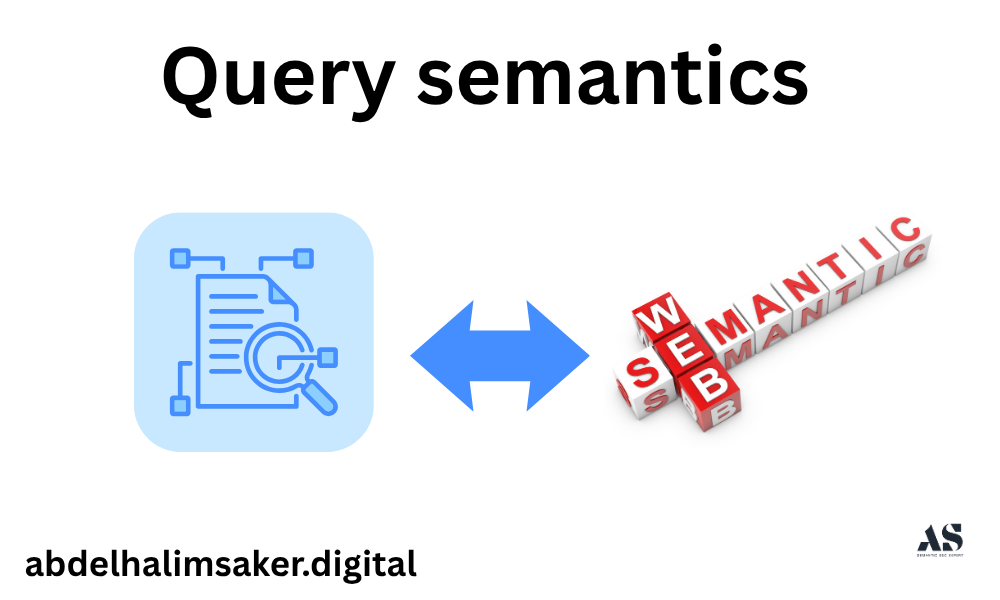
Query semantics is the study of how search engines interpret the meaning and intent behind user queries.
It involves understanding not only what users type but what they mean.
In SEO, query semantics guides how content aligns with search intent, entity relationships, and linguistic context. It’s the foundation of semantic search, where algorithms interpret concepts and context, not just words.
Search engines like Google use query semantics to bridge the gap between surface text (keywords) and deep meaning (intent and entities). This process allows Google to deliver results that satisfy both explicit and implicit intent.
How Google Understands Query Meaning
Google interprets query meaning using a combination of linguistic parsing, semantic embeddings, and entity recognition.
This process transforms a raw text query into a machine-understandable intent vector.
Step 1: Query Tokenization and Parsing
Google first breaks a query into smaller tokens — individual words or meaningful fragments.
Then it identifies the syntactic relationships among them.
Example:
Query: “best laptop for graphic design”
- Tokens: best | laptop | for | graphic | design
- Relations: (laptop) → (used for) → (graphic design)
This structure helps Google detect functional intent — in this case, a comparative transactional query looking for product recommendations.
Step 2: Entity and Context Recognition
Once tokenized, Google identifies entities (specific, recognizable concepts) and connects them to nodes in its Knowledge Graph.
Example:
- Entity: Laptop →
Product - Entity: Graphic design →
OccupationorActivity - Relation: Product used for Activity
This entity-based mapping allows Google to generalize meaning across variations, such as “top computers for designers” or “graphic design notebooks.”
Despite wording differences, Google understands the same intent.
Step 3: Intent Vector Generation
After recognizing entities, Google encodes the query into a semantic vector — a numerical representation of meaning.
These vectors let algorithms measure similarity between different queries and content.
For instance, “cheap laptop for editing” and “budget laptop for design” may share a semantic proximity score above 0.85, signaling a similar intent cluster.
This enables contextual retrieval rather than keyword matching, where search engines rank pages based on semantic fit.
Step 4: Query Rewriting and Interpretation
Google often rewrites queries internally to match known patterns or intents.
For example:
- “Capital of Netherlands” → “What is the capital of the Netherlands?”
- “SEO consultant near me” → “Find SEO consultant in [user location]”
This rewriting phase ensures the algorithm interprets the core semantic function of the query — whether it seeks information, navigation, or action.
Types of Search Queries in Semantic SEO
Semantic SEO classifies queries by intent type. Understanding these query categories helps content creators align structure, wording, and purpose with the user’s mental model.
The four primary types are informational, navigational, transactional, and representative queries.
| Query Type | Primary Goal | Example | Optimal Content Type |
|---|---|---|---|
| Informational | Learn something | “What is query semantics?” | Guides, definitions, explainers |
| Navigational | Find a known brand or source | “Google NLP documentation” | Homepage, brand pages |
| Transactional | Perform an action or purchase | “Buy SEO course online” | Landing pages, CTAs |
| Representative | Concept groupings or query patterns | “Best SEO tools”, “Top keyword clusters” | Comparative or listicle content |
Let’s analyze the two nuanced subtypes — represented and representative queries — that often define semantic differentiation in Google’s query understanding.
Represented Queries — Specific Forms Users Type
Represented queries are the exact text strings users type into the search bar.
They represent surface-level phrasing — what users express linguistically.
Example:
- “how to improve keyword rankings”
- “boost SEO positions quickly”
Both are represented queries with similar meaning but different wording.
Google interprets them using its query embedding models, recognizing shared context despite surface variation.
Semantic triple:
- (Represented query) → (expresses) → (user intent)
For SEO, analyzing represented queries helps identify lexical diversity — the variations users use to express the same goal.
This data can be sourced from Google Search Console or People Also Ask results to optimize content coverage.
Representative Queries — Core Intent Pattern Google Groups Them Under
Representative queries are the normalized semantic versions Google uses internally to categorize search intent.
For example:
- Represented: “cheap laptops for students”
- Representative: “best student laptops”
Though phrased differently, both queries share semantic equivalence and belong to one intent vector cluster.
Semantic triple:
- (Google) → (groups) → (represented queries under representative query)
This system allows algorithms to consolidate ranking signals and avoid duplication across similar keyword forms.
SEO professionals must focus on representative intent, not only on keyword lists.
How Query Semantics Impacts Content Optimization
Query semantics directly shapes how content should be structured, written, and optimized.
Search engines evaluate whether each section of content aligns with the intent vector of the user’s query cluster.
Aligning Paragraphs and Headings with Query Intent
Each heading (H1, H2, H3) should map to a specific intent category — defining why the user searches, not only what they search.
| Heading Level | Intent Role | Example |
|---|---|---|
| H1 | Defines main intent | “What Is Query Semantics” |
| H2 | Expands intent attributes | “How Google Understands Query Meaning” |
| H3 | Supports granular user intent | “Representative Queries in SEO” |
This alignment creates contextual cohesion, where every paragraph reinforces a semantic relationship between the query and its entities.
Example of alignment:
If a user searches “semantic meaning of search queries,” Google expects coverage of:
- Query parsing
- Intent classification
- Entity recognition
- Ranking implications
Missing these dimensions weakens query-document alignment, reducing ranking potential.
Using Intent Vectors for Semantic ptimization
Each paragraph represents an intent vector, which can be measured using co-occurrence terms and entity relevance.
Example of an optimized paragraph vector:
“Google uses transformer-based NLP models like BERT to interpret user queries by analyzing semantic relations between entities, not just keyword matches.”
This vector combines entity (BERT), predicate (interprets), and object (user queries), forming a strong semantic triple that matches informational query intent.
Writers can analyze intent vectors through:
- LSI keyword co-occurrence
- Entity salience scoring
- NLP semantic similarity analysis
These metrics help validate whether content semantically matches user queries.
Avoiding Query Drift in Content Creation
Query drift occurs when content deviates from the original intent cluster — confusing search engines about the topic’s purpose.
For example, mixing navigational elements in an informational article can dilute ranking signals.
Rule: One page = One query intent cluster.
Use internal links to connect different intent layers rather than merging them into a single article.
Practical Methods to Analyze Query Semantics
To apply query semantics effectively, SEOs and content strategists can use several analytical methods to decode search intent patterns and cluster behavior.
1. SERP Intent Clustering
Analyze the top 10 results for a query.
Group them by their intent type — informational, navigational, or transactional.
Example:
Query: “SEO audit tools”
- Top results: listicles → informational
- Few product pages → transactional
- Dominant pattern = mixed intent
SERP clustering reveals what Google interprets as the dominant user intent and informs which content format to use.
2. Co-Occurrence and Semantic Similarity Analysis
Examine terms that frequently appear together in high-ranking pages.
This identifies semantic neighborhoods that reinforce entity relationships.
Tools: InLinks, SurferSEO, TextRazor, or Google NLP API.
Example output:
For “query semantics,” high co-occurrence terms include:
- search intent
- semantic search
- NLP models
- Google BERT
Embedding these entities improves contextual alignment with how Google defines the topic in its knowledge network.
3. Search Behavior Observation
Monitor behavioral metrics (CTR, dwell time, scroll) to evaluate intent satisfaction.
High dwell time suggests the content fulfills the semantic expectations of the query.
Example:
If “query semantics explained” has an average dwell of 3 minutes but “semantic SEO meaning” only 45 seconds, the latter may miss intent alignment.
Use these signals to fine-tune heading clarity, paragraph density, and entity inclusion.
Connecting Query Semantics with Topical Maps
Query semantics defines how topics, entities, and attributes connect within a topical map.
It ensures that every content node corresponds to a distinct query-intent vector, maintaining both hierarchical and contextual integrity.
Query Semantics as the Foundation of Topical Maps
In Koray’s Topical Authority model, topical maps are entity graphs representing relationships between subjects.
Query semantics provides the meaning layer that binds these nodes logically.
Semantic triple example:
- (Query) → (defines) → (topic node)
- (Topic node) → (relates to) → (supporting entity)
Example:
Main topic: “Semantic SEO”
Subtopics: “Query Semantics”, “Entity Relationships”, “Contextual Hierarchy”
Each subtopic corresponds to a unique query pattern, ensuring no topical overlap.
How Query Semantics Shapes Inter-Node Connections
When two nodes share similar intent vectors, they can be interlinked for semantic reinforcement.
This creates horizontal authority — where relevance flows between them.
Example:
- “What Is Query Semantics” → links to → “How Google Uses Entities”
- “Search Intent Classification” → links to → “Behavioral Data in SEO”
These links reflect logical continuity based on semantic proximity rather than random anchor placements.
Query-Level Entities and Attributes
Each node in a topical map should map to entities and attributes extracted from dominant query semantics.
| Node | Entity | Attribute | Relation |
|---|---|---|---|
| Query Semantics | Search Intent | Entity Recognition | defines |
| Topical Authority | Content Depth | Trust Signals | strengthens |
| Contextual Hierarchy | Site Structure | Semantic Layers | organizes |
This relational mapping ensures Google perceives the site as a coherent knowledge system.
Practical Application: Building a Semantic Topical Map
- Extract query list from keyword tools and Search Console.
- Cluster queries by semantic similarity and intent.
- Assign entity roles (main entity, sub-entity, attribute).
- Design hierarchy (macro → meso → micro).
- Create interlink map to express semantic relationships.
By integrating query semantics at every stage, you convert isolated keywords into meaningful entities — building a machine-readable topical structure.
How Query Semantics Reinforces Topical Authority
When every content piece aligns with a defined query-intent pattern, Google recognizes your domain as a specialized source of truth.
Mechanism:
- Consistent intent coverage signals depth and expertise.
- Accurate entity alignment improves retrieval confidence.
- Behavioral data validates user satisfaction.
Over time, this creates a semantic trust loop:
- (Accurate intent matching) → (Higher engagement) → (Positive historical data) → (Improved authority)
Thus, query semantics is not just about keyword meaning — it’s about semantic precision that shapes entire knowledge ecosystems.
Example: Applying Query Semantics in Practice
Scenario: A content strategist wants to rank for “AI content optimization.”
Steps using query semantics:
- Analyze SERP results to detect dominant intent — informational (guides, comparisons).
- Identify related entities — AI tools, content scoring, semantic SEO.
- Group represented queries — “AI content writing,” “optimize content with AI.”
- Build a representative query cluster — “AI-based content optimization.”
- Structure content sections to match intent:
- H1: What Is AI Content Optimization
- H2: How AI Tools Improve Semantic SEO
- H3: Best Practices for Query-Level Optimization
This ensures the article mirrors the query’s semantic intent, improving both ranking and relevance.
The Future of Query Semantics in Search
As large language models evolve, query semantics becomes more predictive than reactive.
Future search systems will use real-time context modeling to interpret intent evolution during user sessions.
Emerging trends include:
- Dynamic intent prediction based on previous interactions.
- Cross-device semantic continuity.
- Queryless retrieval via conversational AI.
Search will transition from keyword-based access to context-driven understanding, where engines interpret the semantic continuum of user needs.
